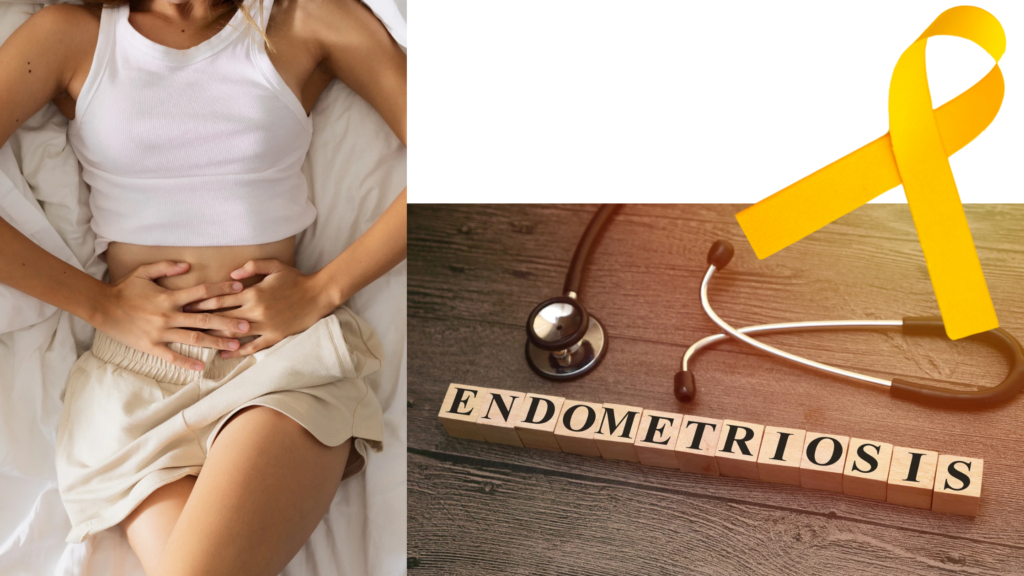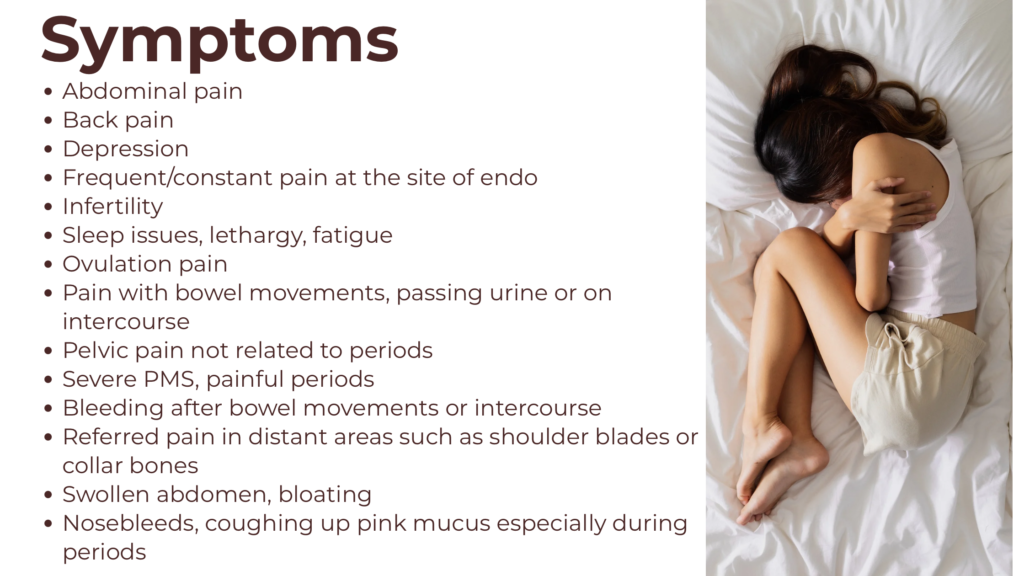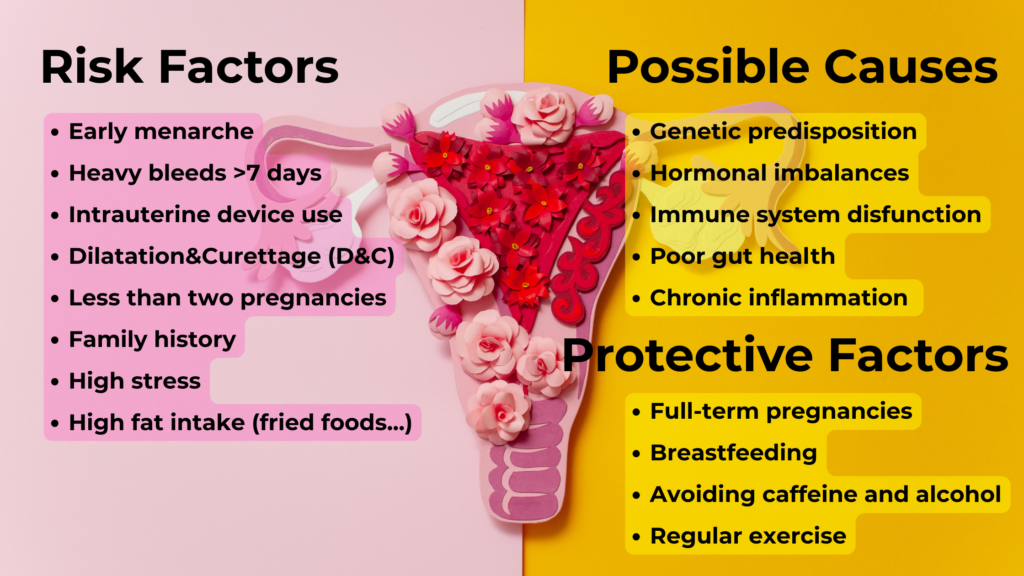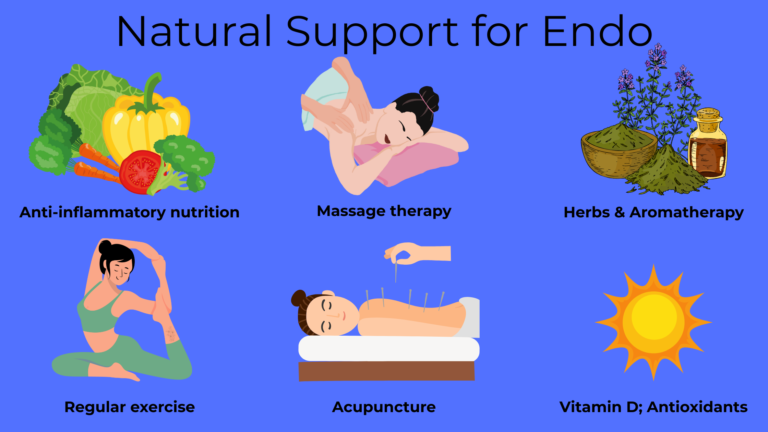
Endometriosis is one of the most common gynaecological problems worldwide and a leading cause of hysterectomy. It affects approximately 10% of women of reproductive age which means roughly 190 million women and girls globally. In UK 1 in 10 women means about 1.5 milion. Those are huge numbers!
What it Actually Is?
It is a condition where the endometrial tissue (the lining of the uterus) grows in locations outside of the uterus. The endometrial cells can be on ovaries, fallopian tubes, bowel, bladder and anywhere else in the abdomen; rarely even in other parts of the body such as respiratory tract and even brain.
The misplaced tissue causes all sorts of symptoms including often debilitating period pain, extremely heavy periods and fertility issues.
The tissue still responds to the cyclic hormonal changes causing bleeding and irritation of local tissues which leads to inflammation (e.g. of the peritoneum). Repeated inflammation can cause scarring and adhesions that leads to pain and dysfunction of the organs (e.g. infertility which affects 30-40% of women with endometriosis).

How is Endo Diagnosed
Because endometriosis symptoms can be similar to other conditions and sometimes may not even be taken too seriously, it takes on average 7 years to get the right diagnosis!
Despite that the symptoms are some of the main leads towards the diagnosis. Based on your history your doctor will suggest various tests to confirm the suspicion and to determine the stage (I. – IV.) of your condition.
- Pelvic examination – basically vaginal examination to check you pelvic area (cervix, uterus, ovaries)
- Ultrasound – abdominal or transvaginal, it can help identify endometrial cysts on ovaries and deep endometriosis
- MRI – provides detailed images of pelvic or other organs
- Laparoscopy – this is the only way to get a definitive diagnosis and sometimes it may even be possible to remove the stray tissue at the same time
- CA-125 marker blood test – this is a marker for certain cancers but it can also be elevated in endometriosis. It is used more to distinguish the severity of the condition and to monitor the effects of treatment.
Conventional Treatment
Once you are diagnosed correctly, the treatment offered may include pharmaceutical as well as surgical options. If you have only mild symptoms, the treatment may actually be to do nothing.
Pharmaceutical options include NSAID (such as ibuprofen) mainly to manage pain and inflammation, and hormonal therapies to modulate the cyclic symptoms, bleeding and possibly support fertility.
Surgical approach can be conservative where the misplaced endometrial tissue or adhesions are destroyed and removed to restore normal function as much as possible, or radical such as hysterectomy (including fallopian tubes and ovaries).
Unfortunately none of these methods guarantees permanent recovery. Endometriosis has a high recurrence rates of up to 20%. In terms of the pharmacological approaches the pain and other symptoms typically come back once the medication is stopped.

Natural Support for Endo
Although conventional medicine does not offer a definitive cure for endo at this time, there are many natureal, holistic options to help elleviate your symptoms and support your fertility.
Power of Nutrition
Dietary adjustments are a part of the holistic approach to managing endometriosis symptoms. They can target the root causes such as underlying hormonal imbalances and inflammation, while supporting the body’s natural healing mechanisms.
- Omega-3 Fatty Acids – May reduce pelvic pain (esp. in combination with vitamin D); in combination with resveratrol they can reduce inflammation and encourage new blood vessel formation. Best food sources: fatty fish, walnuts, flaxseeds, chia seeds, seaweed etc.
- Magnesium – Reduces muscle spasms and cramps as well as the inflammatory effects of histamine and prostaglandins, mitigates hormonal imbalances. Epsom salt baths or foods such as legumes, nuts, whole grains and dark green leafy veg can be great sources.
- Pre- and Probiotics – Help lower inflammation in endometriosis and restore gut microbiome balance which can lessen symptoms such as IBS. Some of the best prebiotic foods are garlic, onions, bananas or asparagus; probiotic foods include natural yogurt, kefir, sauerkraut, kimchi and tempeh.
- Cysteine – Assists in inhibiting the proliferation of endometrial cells. It is also a precursor to glutathione and when combined with alpha lipoic acid and bromelain, it can help improve endometriosis-associated pelvic pain. High-protein foods such as chicken, turkey, dairy or eggs are rich in cysteine.
- Turmeric – Has potent anti-inflammatory, antioxidant, anti-tumour, and anti-angiogenesis effects making it possibly capable of inhibiting the growth of endometrial tissue.
- Vitex Agnus Castus – Has a long history of use in traditional herbal medicine for menstrual disorders and hormonal imbalances. It also has anti-inflammatory and antioxidant properties that can help stop the growth of endometrial tissue by regulating oestrogen metabolism.
- Vitamin D – Can help improve chronic inflammatory and autoimmune responses associated with endometriosis. Research shows that women with endo have lower vitamin D levels and there is also a correlation between the severity and progression of endometriosis and vitamin D level. Best source of vitamin D is exposure of our skin to the sun. Good food sources include oily fish and egg yolks from free range hens.
- Vitamin C and E – They have a huge antioxidant role that leads to reduction in severity of endometriosis symptoms. Citrus fruits, red peppers, broccoli and blackcurrants are some of the best vitamin C sources while olive oil, nuts, seeds and avocados provide us with good amounts of vitamin E.
- Bromelain – Group of enzymes with anti-inflammatory effect that offers pain relief in a variety of conditions. Main source of bromelain is pineapple but it is also found in kiwis and bananas.
Natural Therapies
Natural therapies focus on reducing inflammation and supporting the body’s self-healing abilities.
- Heat – can help relax pelvic muscles and alleviate menstrual cramps. Heating pads, warm baths, or hot water bottles are some of the ways to utilize heat therapy.
- Physical therapy – pelvic floor therapy addresses muscle dysfunction and pelvic pain through targeted exercises, manual therapy, and relaxation techniques.
- Herbs and Aromatherapy – herbs such as ginger, cinnamon, and chamomile have anti-inflammatory and analgesic properties that can provide relief and can be used as teas or tinctures. Essential oils such as lavender, clary sage, and peppermint also have calming and analgesic effects; they can be used in a gentle abdominal massage or in a form of warm compress.
- Stress management – chronic stress can trigger inflammation and contribute to hormonal imbalances. Techniques such as meditation, yoga, deep breathing exercises, and mindfulness practices can help promote relaxation, improve sleep, and assist with mood-related issues.
- Acupuncture – can alleviate pain and promote healing as well as lower anxiety and pain.
- Massage therapy – regular massage or Mayan abdominal/Mizan therapy can help with dysmenorrhea (painful period) caused by endometriosis. Specialised treatments such as Mayan or Mizan can also help with adhesions, blood circulation through pelvic organs, and support fertility.
- TENS machine – electrical stimulation to the nerves of the pelvis can help reduce pain and discomfort.
- Exercise – regular physical activity helps release endorphins that can help manage pain, improve mood and reduce inflammation.

Homeopathy for Endometriosis
Homeopathy offers a gentle, holistic approach to supporting women with endometriosis. Rather than simply suppressing symptoms, it aims to stimulate the body’s natural healing response and address the underlying imbalances contributing to chronic pain, hormonal disruption, and inflammation.
What makes homeopathy unique is that it’s entirely individualised. A homeopath will look beyond the diagnosis to consider your full picture — physical symptoms, emotional wellbeing, menstrual patterns, and how your symptoms affect your daily life as well as your overall health history.
Some commonly used remedies in endometriosis include:
Sepia – often indicated for women who feel emotionally drained, irritable, and heavy in the pelvic area, especially before or during their period.
Magnesium phosphoricum – known as the “homeopathic painkiller,” it can help relieve cramping pains that improve with warmth and pressure.
Lachesis – useful when symptoms are left-sided, worse before the period, and accompanied by a sense of congestion or intensity.
Pulsatilla – for those with changing symptoms, a gentle and tearful disposition, and relief from open air.
While over-the-counter remedies can sometimes provide relief, the best results often come from working with a qualified homeopath who can match you with the most appropriate remedy for your constitution and symptom pattern.
When integrated into a wider holistic plan — including nutrition, stress management, and lifestyle support — homeopathy can be a powerful ally in navigating endometriosis naturally.
Remember, healing is a journey, not a one-size-fits-all solution. A skilled holistic practitioner can guide you toward long-lasting relief and improved quality of life.
If you or someone you know is struggling with endometriosis, feel free to reach out. Together, we can explore gentle, holistic ways to heal.
And if you would like to learn more about homeopathy, natural remedies and holistic lifestyle for the whole family, I invite you to join our Mother’s Herbal Club. You will have the opportunity to join our weekly live zoom workshops and Q&As, watch all the past recordings and join our vibrant, supportive WhatsApp community for instant advice and chitchat ![]()
